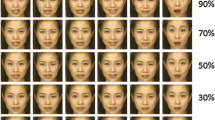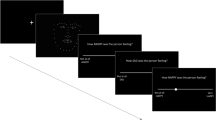Abstract
Ten autistic individuals (mean age: 12;7 years, SD 3.8, range 5;10–16;0), 10 Down individuals (12;3 years, SD 3.0, range 7;1–16;0), and a control group of 10 children with normal development (mean age: 6;3 years, SD 1.6, range 4;0–9;4), matched for verbal mental age, were tested on a delayed-matching task and on a sorting-by-preference task. The first task required subjects to match faces on the basis of the emotion being expressed or on the basis of identity. Different from the typical simultaneous matching procedure the target picture was shortly presented (750 msec) and was not visible when the sample pictures were shown to the subject, thus reducing the possible use of perceptual, piecemeal, processing strategies based on the typical features of the emotional facial expression. In the second task, subjects were required to rate the valence of an isolated stimulus, such as facial expression of emotion or an emotional situation in which no people were represented. The aim of the second task was to compare the autistic and nonautistic children's tendency to judge pleasantness of a face using facial expression of emotion as a meaningful index. Results showed a significantly worse performance in autistic individuals than in both normal and Down subjects on both facial expression of emotion subtasks, although on the identity and emotional situation subtasks there were no significant differences between groups.
Similar content being viewed by others
REFERENCES
American Psychiatric Association, (1987). Diagnostic and statistical manual of mental disorders (3rd ed., Rev.), Washington, DC: Author.
Baron-Cohen, S. (1989). Perceptual role-taking and protodeclarative pointing in autism. British Journal of Developmental Psychology, 7, 113–127.
Baron-Cohen, S., Spitz, A., & Cross, P. (1993). Do children with autism recognise suprise? A research note. Cognition and Emotion, 7, 507–516.
Barthélemy, C., Adrien, J. L., Tanguay, P., Garreau, B., Fermanian, J., Roux, S., Sauvage, D., & Lelord, G. (1990). The Behavioral Summarized Evaluation (BSE): Validity and reliability of a scale for the assessment of autistic behaviors. Journal of Autism and Developmental Disorders, 20, 189–204.
Bradshaw, J., & Nettleton, N. (1981). Human cerebral asymmetry. Englewood Cliffs, NJ: Prentice-Hall.
Braverman, M. (1986). Cognitive measures of affect competence in pervasive developmental disorders. Unpublished doctoral dissertation. Boston, MA: Boston University
Braverman, M., Fein, D., Lucci, D., & Waterhouse, L. (1989). Affect comprehension in children with pervasive developmental disorders. Journal of Autism and Developmental Disorders, 19, 301–316.
Bruce, V. (1988). Recognising faces. Hillsdale, NJ: Erlbaum.
Bruyer, R. (1986). The neuropsychology of face perception and facial expression. Hillsdale, NJ: Erlbaum.
Bryson, C. Q. (1972). Short-term memory and crossmodal information processing in autistic children. Journal of Learning Disabilities, 5, 81–91.
Buck, R. (1982). Spontaneous and symbolic nonverbal behavior and the ontogeny of communication. In R. S. Feldman (Ed.), Development of nonverbal behavior in children. New York: Springer.
Cronbach, L. (1951). Coefficient alpha and the internal structure of tests. Psychometrics, 16, 297–334.
Damasio, A. R., & Van Hoesen, G. W. (1983). Emotional disturbances associates with focal lesions of the limbic frontal lobe. In K. M. Heilman & P. Satz (Eds.), Neuropsychology of human emotion. New York: Guilford.
Davidoff, J. B. (1986). The specificity of face perception: Evidence from psychological investigations. In R. Bruyer (Ed.), The neuropsychology of face perception and facial expression. Hillsdale, NJ: Erlbaum.
Dimond, S. J. (1980). Neuropsychology: A textbook of systems and psychological functions of the human brain. London: Butterworth.
Dunn, J. (1965). Expanded manual for the Peabody Picture Vocabolary Test. Circle Pines, MN: American Guidance Service.
Ekman, P., & Friesen W. V. (1975). Unmasking the face. A guide to recognizing emotions from facial cues. Englewood Cliffs, New York: Prentice-Hall.
Frith, U. (1989). Autism: Explaining the enigma. Oxford: Blackwell.
Gray, J. M., Frazer, W. L., & Leudar, I. (1983). Recognition of emotion from facial expression in mental handicap. British Journal of Psychiatry, 142, 566–571.
Greenwald, M. K., Cook, E. W., & Lang, P. J. (1989). Affective judgment and psychophysiological response: Dimensional covariation in the evaluation of pictorial stimuli. Journal of Psychophysiology, 3, 51–64.
Hermelin, B., & O'Connor, N. (1975). The recall of digits by normal, deaf and autistic children. British Journal of Psychology, 66, 203–209.
Hobson, R. P. (1986a). The autistic child appraisal of expressions of emotion. Journal of Child Psychology and Psychiatry, 27, 321–342.
Hobson, R. P. (1986b). The autistic child appraisal of expressions of emotion: A further study. Journal of Child Psychology and Psychiatry, 27, 671–680.
Hobson, R. P. (1991). Methodological issues for experiments on autistic individuals' perception and understanding of emotion. Journal of Child Psychology and Psychiatry, 32, 1135–1158.
Hobson, R. P. (1993). Autism and the development of mind. Lawrence Hove, Sussex, U. K.: Erlbaum.
Hobson, R. P., Ouston, J., & Lee, A. (1988a). Emotion recognition in autism: coordinating faces and voices. Psychological Medicine, 18, 911–923.
Hobson, R. P., Ouston, J., & Lee, A. (1988b). What's in a face? The case of autism. British Journal of Psychology, 79, 441–453.
Homa, D., Haver, B., & Schwartz, T. (1976). Perceptibility of schematic face stimuli: Evidence for a perceptual Gestalt. Memory and Cognition, 4, 176–185.
Inoue, M., & Kobayashi, S. (1993). Assessment of stimulus preference of children with autism. Japanese Journal of Behavior Therapy. 19, 37–47.
Jennings, W. B. (1973). A study of the preference for affective cues in autistic children, Unpublished doctoral dissertation, Memphis State University, Memphis, TN.
Kanner, L. (1943). Autistic disturbances of affective contact. Nervous Child, 2, 217–250.
Làdavas, E. (1982). The development of facedness. Cortex, 18, 535–545.
Lang, P. J., Öhman, A., & Vaitl, D. (1988). The international affective picture system [Photographic slides]. Gainesville, FL: University of Florida, Center for Research in Psychophysiology.
Lanzi, G., Zambrino, C. A., Balottin, U., Rossi, G., Gerardo, A., Bettaglio, E., & Manfredi, P. (1996, May). Clinical application of BSE scale in diagnostic approach to autism and pervasive developmental disorders. Paper presented at 5th Congress Autism, Europe, Barcelona.
Lelord, G., & Savage, D. (1994). L'autismo infantile. Milano, Italy: Masson.
Lincoln, A. J., Mark, H. A., & Kilman, A. (1995). The Assessment and interpretation of intellectual abilities in people with autism. In E. Schopler & G. B. Mesibov (EDs.) Learning and cognition in autism. New York: Plenum Press.
Loveland, K., & Landry, S. (1986). Joint attention and language in autism and developmental language delay. Journal of Autism and Developmental Disorders, 16, 335–349.
Maurer, H., & Newbrogh J. R. (1987). Facial expression of mentally retarded and non retarded children: I Recognition by mentally retarded and nonretarded adults. American Journal of Mental Deficiency, 91, 505–510.
Mermelstein, R., Banks, W., & Prinzmetal, W. (1979). Figural goodness effects in perception and memory. Perception and Psychophysics, 26, 472–480.
Mueser K. T., Doonan, R., Penn, D. L., & Blanchard, J. J. (1996). Emotion recognition and social competence in chronic schizophrenia. Journal of Abnormal Psychology, 105, 271–275.
Murphy, S. T., & Zajonc, R. P. (1993). Affect, cognition, and awareness: affective priming with optimal and suboptimal stimulus exposure. Journal of Personality and Social Psychology, 64, 723–739.
Ozonoff, S., Pennington, B. F., & Rogers, S. J. (1990). Are there emotion perception deficits in young autistic children?. Journal of Child Psychology and Psychiatry, 31, 343–361.
Ozonoff, S., Pennington, B. F., & Rogers, S. J. (1991). Executive function deficits in high-functioning autistic individuals: Relationship to theory of mind. Journal of Child Psychology and Psychiatry, 32, 1081–1105.
Prior, M. R., & Chen, C. S. (1976). Short-term and serial memory in autistic, retarded and normal children. Journal of Autism and Childhood Schizophrenia, 6, 121–131.
Prior, M. R., Dahlstrom, B., & Squires, T. L. (1990). Autistic children's knowledge of thinking and feeling states in other people. Journal of Child Psychology and Psychiatry, 31, 587–601.
Raven, J. C. (1960). The standard progressive matrices: Sets A, B, C, D, and E. London: H. K. Lewis.
Rutter, M. (1978). Diagnosis and definition. In M. Rutter & E. Schopler (Eds.), Autism: A reappraisal of concepts and treatment. New York: Plenum Press.
Suberi, M., & McKeever, W. F. (1977). Differential right hemispheric memory storage of emotional and nonemotional faces. Neuropsychologia, 5, 757–768.
Tantam, D., Monagham, L., Nicholson, H., & Stirling, J. (1989). Autistic children's ability to interpret faces: A research note. Journal of Child Psychology and Psychiatry, 30, 623–630.
Teunisse, J. P. (1996, May). Face processing strategies in autistic individuals. Paper presented at the 5th Congress Autism-Europe, Barcelona.
Tucker, D. M. (1981). Lateral brain function, emotion, and conceptualization. Psychological Bulletin, 89, 514–535.
Vrana, S. R., Spence, E. L., & Lang, P. J. (1988). The startle probe response: A new measure of emotion? Journal of Abnormal Psychology, 97, 487–491.
Wechsler, D. (1958). The measurement and appraisal of adult intelligence. Baltimore: Williams and Wilkins.
Week, S. J., & Hobson, R. P. (1987). The salience of facial expression for autistic children. Journal of Child Psychology and Psychiatry, 28, 137–151.
Wing, L. (1976). Early Childhood Autism. Oxford: Pergamon Press.
World Health Organization. (1992). International statistical classification of disease, injuries and causes of death (9th Rev.). Geneva: Author.
Author information
Authors and Affiliations
Rights and permissions
About this article
Cite this article
Celani, G., Battacchi, M.W. & Arcidiacono, L. The Understanding of the Emotional Meaning of Facial Expressions in People with Autism. J Autism Dev Disord 29, 57–66 (1999). https://doi.org/10.1023/A:1025970600181
Issue Date:
DOI: https://doi.org/10.1023/A:1025970600181




